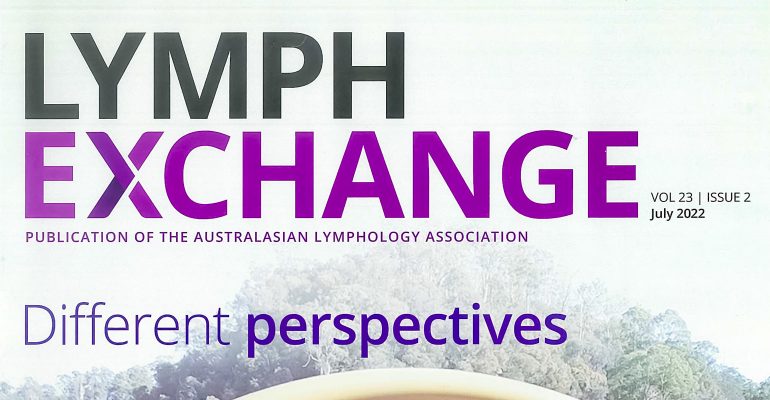This article by Kate Perkins, Dr Catherine Norton and Amy Chau featured in the July issue of Lymph Exchange. It outlines the result of introducing laser, or photobiomodulation therapy (PMBT), into the treatment protocol of a case of dependent lower limb lymphoedema. The introduction follows and a PDF of the full article can be downloaded.
Introduction
Photobiomodulation therapy
Sunlight or heliotherapy was used by ancient Egyptians, Indians and Chinese to treat various diseases. Histories reveal therapeutic benefits of light sources used as medical treatments – for example, Florence Nightingale reportedly wheeled her patients into sunlight to assist with recovery. Michael Hamblin has written about the history of light therapy, outlining the research of its development.
Current PBMT uses non-ionising optical radiation in the visible or near-infrared spectral range produced by laser diodes or light emitting diodes (LEDs). The phrase laser therapy can be applied when specifically referring to laser devices. However, photobiomodulation is the preferred nomenclature for what was previously referred to as low level laser, soft laser, low intensity laser, low power laser or cold laser. Hamblin et al. emphasised using this term to reduce confusion and increase consistency across research and practice.
Cellular effects of PBMT
PBMT in the treatment of lymphoedema is used for reducing harder, more fibrotic tissue, clearing drainage basin lymph nodes3 and increasing lymphatic function.1 Research has demonstrated that biologically, PBMT causes vasodilation of superficial lymphatics and blood vessels, increasing lymph transportation and blood flow. But 3 powerful cellular Laser treatment of a case of lower leg lymphoedema effects of PBMT lead to enhanced tissue regeneration, increased lymphatic performance, and effective analgesia accelerating wound healing.
Endogenous chromophores (light sensitive molecules) absorb PBMT to elicit photophysical and photochemical events without eliciting thermal damage. Cytochrome C oxidase, the main chromophore in cell mitochondria, absorbs light, which increases adenosine triphosphate (ATP) production resulting in more cell energy, better repair and downregulation of pain and inflammation.
Secondly, increased nitric oxide is produced by PBMT with 2 main functions: as a vasodilator increasing lymph transportation and blood flow; and as a secondary messenger molecule leading to the activation of chemical pathways that enhance cellular repair mechanisms.
PBMT also slowly and marginally upregulates the production of natural by-products of metabolism – reactive oxygen species (ROS). Low ROS concentrations have beneficial effects on cells, operating as signalling molecules that activate nucleus cellular processes that produce repair mechanisms and downregulate inflammation cycles.
These effects of PBMT could therefore potentiate lymphoedema therapy to provide faster clinical outcomes of reduction of pain, inflammation and oedema.
Side effects and precautions
A systematic review of the safety and efficacy of PBMT found there are no known negative side effects of PBMT7, concluding that PBMT does not influence tumours, cancer treatment outcomes or overall patient survival rates. While some patients feel a comfortable, warm sensation in the treatment area, most patients feel nothing. No pain, heat, redness, or swelling occurs during or after PBMT. However, as per guidelines, practitioners and patients must wear safety glasses for eye protection.
Variations in PBMT devices for lymphoedema
A variety of PBMT devices exist ranging from handheld Class 1, 5-Watt devices to hands-free robotised scanning Class 4, 75-Watt devices. Several differences exist between Class 1 and Class 4 lasers, including treatment time. Class 4 lasers are five times faster than Class 1 lasers, taking 18 seconds to treat a small trigger point compared with a 100-second treatment to deliver the same dose using a Class 1 laser.
In this case report, the Class 4 Multi-wave Locked System (MLS®) was used as its unique, patented synchronised laser system safely delivers a balance of two wavelengths: 905 nm pulsed emissions and 808 nm continuous emissions. The superpulsed laser treats pain and promotes healing; the continuous emissions reduce inflammation and oedema.9 Therefore, this device may simultaneously treat pain, inflammation, and oedema. The optical design of the delivery system transfers energy up to 5 cm deep into the tissue without generating heat. The synchronised wave results in a synergistic effect where both the analgesic and anti-oedema effects are greater than if two single lasers had been used.
Download a PDF of the full article


